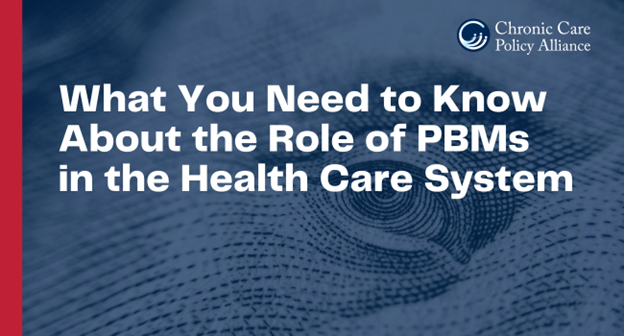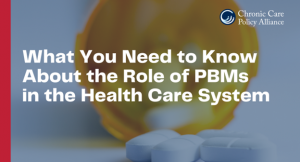For many Americans who are managing a chronic condition, the journey to pick up prescriptions is filled with a myriad of access barriers – including treatment restrictions, utilization management protocols, and high out-of-pocket costs. While patients and their families often struggle to access the medicines they need to treat their conditions, insurance industry middlemen, known as Pharmacy Benefit Managers (PBMs), continue to institute harmful policies and practices that exacerbate those challenges for the sake of greater profits. Amid ongoing discussions about how to improve our health care system, policymakers must address how PBM practices impact access, affordability, and outcomes for patients with complex and chronic conditions.
The Role of PBMs in a Broken Health Care System
While PBMs were initially tasked with processing pharmacy claims, their role and influence within the health care system and prescription drug supply chain has evolved and expanded over time. Despite what we know about PBMs today, a lack of necessary oversight and regulation has allowed these industry middlemen to create loopholes through which they often take advantage of patients, institute treatment barriers at almost every step in a patient’s journey, and increase their profits to the detriment of vulnerable populations.
PBMs negotiate rebates with manufacturers of prescription drugs, generating savings that should, in theory, be passed on to patients who are accessing those medicines at the pharmacy counter. Unfortunately, PBMs often fail to pass rebates on to patients who are already struggling to afford and access their medications. As a result, PBMs recoup profits through these rebates while patients with rare and chronic conditions face challenges affording the out-of-pocket costs for their medication. For example, in 2020, brand name prescription drug companies provided $187 billion in total discounts, rebates and other price concessions. While these concessions should have significantly lowered patient out-of-pocket costs at the pharmacy counter – during a time when people continue to be stretched by the economic uncertainty of an ongoing pandemic – they instead went to PBMs and the insurers that employ them, leaving patients with difficult decisions to make about their care.
How PBMs Create Access & Affordability Challenges for Patients
In recent years, PBMs have distorted competition, reduced treatment choices for consumers, and ultimately, increased the out-of-pocket cost burden for patients who rely on prescription medications. This system has real world implications for patients that stretch beyond the price they are required to pay at the pharmacy counter. PBMs are directly interfering with the role that physicians play to work with patients to manage their health and specific conditions. PBMs can control a drug formulary, determining which drugs are and are not included, and have the freedom to institute discriminatory practices such as non-medical switching, prior authorization, and adverse tiering. All of these practices limit patient access to the treatments their physician deemed most appropriate for them and disproportionately impact patient communities who often already face heightened barriers to access for the treatments they need, including people of color and lower-income individuals.
Recent data illustrates the challenges patients are facing to access and afford their treatments today.
- Policies are Shifting Greater Cost Burden onto Patients. Between 2008 and 2018, deductibles for covered workers increased by an average of 212%, signaling that health plans are shifting the cost burden onto patients.
- Patients Abandon Their Medications When Costs Go Up. When out-of-pocket treatment costs reach or exceed $250, 70% of patients abandon their prescriptions at the pharmacy counter. In 2020 alone, patients starting a new therapy abandoned 55 million prescriptions at pharmacies.
- The COVID-19 Pandemic Has Exacerbated Access and Affordability Challenges. Between April 2020 and April 2021, 46% of surveyed patients said they or someone in their immediate household had not been able to afford the out-of-pocket costs for a prescription treatment.
If PBMs continue to have the ability to implement discriminatory practices and fail to share rebates with patients, they will be partially responsible for millions of patients foregoing their treatment regimens.
Opportunities for Policy Reform
While some states have taken action to protect patients from discriminatory actions from PBMs, the federal government has an opportunity to take action on behalf of all Americans struggling to access treatments for rare, chronic, and other complex conditions.
After initially voting not to open an investigation into PBM practices, the Federal Trade Commission (FTC) recently shifted course, requesting public comments to help analyze these practices on prescription drug affordability and access – bringing about greater discussion on the role of these industry middlemen. This is just one mechanism through which the Biden Administration can work on behalf of patients to rein in these predatory practices.
In order to advance patient-centric public policy, legislators must require increased oversight and transparency to end unfair PBM practices that take advantage of patients with chronic conditions.
Without proper reform to the PBM system, patients with chronic and complex conditions will continue to fall victim to discriminatory practices that harm their health and well-being.



